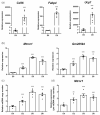Expression Profile of Mouse Gm20594, Nuclear-Encoded Humanin-Like Gene
- PMID: 33763338
- PMCID: PMC7957044
- DOI: 10.15280/jlm.2021.11.1.13
Expression Profile of Mouse Gm20594, Nuclear-Encoded Humanin-Like Gene
Abstract
Background: Mitochondrial-derived peptides (MDPs) such as MOTS-c and humanin have been studied for their cytoprotective functions. In mice, humanin-encoding Mtrnr2 is a mitochondrial pseudogene, and the humanin-like peptide is encoded by the nuclear Gm20594 gene. However, endogenous tissue-specific expression profiles of Gm20594 have not yet been identified.
Methods: Mtrnr1 and Gm20594 expression was profiled via reverse transcription using only oligo(dT) primers from tissues of C57BL6/J mice. To analyze altered expression upon mitochondrial biogenesis, C2C12 myocytes and brown adipocytes were differentiated. Mitochondrial DNA copy numbers were quantified for normalization.
Results: Both Mtrnr1 and Gm20594 were highly expressed in brown adipose tissue. When normalized against mitochondrial content, Mtrnr1 was identified as being highly expressed in the duodenum, followed by the jejunum. In models of mitochondrial biogenesis, both Mtrnr1 and Gm20594 were upregulated during myocyte and brown adipocyte differentiation. Increased Mtrnr1 expression during brown adipocyte differentiation remained significant after normalization against mitochondrial DNA copy number, whereas myocyte differentiation exhibited biphasic upregulation and downregulation in early and late phases, respectively.
Conclusion: Nuclear-encoded Gm20594 showed similar expression patterns of mitochondrial-encoded Mtrnr1. Brown adipose tissue presented the highest basal expression levels of Gm20594 and Mtrnr1. When normalized against mitochondrial DNA copy number, gut tissues exhibited the highest expression of Mtrnr1. Upregulation of Mtrnr1 during mitochondrial biogenesis is independent of mitochondrial content.
Keywords: Gene expression; Gm20594; Mitochondria; Mitochondrial-derived peptide; Mtrnr1.
© 2021 Journal of Lifestyle Medicine.
Conflict of interest statement
CONFLICTS OF INTERESTS None to declare.
Figures




Similar articles
-
Mitochondrial-Derived Peptides Exacerbate Senescence.Rejuvenation Res. 2018 Aug;21(4):369-373. doi: 10.1089/rej.2018.2114. Rejuvenation Res. 2018. PMID: 30058454 Review.
-
Mitochondrial-derived peptides in energy metabolism.Am J Physiol Endocrinol Metab. 2020 Oct 1;319(4):E659-E666. doi: 10.1152/ajpendo.00249.2020. Epub 2020 Aug 10. Am J Physiol Endocrinol Metab. 2020. PMID: 32776825 Free PMC article. Review.
-
Dynamic regulation of genes involved in mitochondrial DNA replication and transcription during mouse brown fat cell differentiation and recruitment.PLoS One. 2009 Dec 24;4(12):e8458. doi: 10.1371/journal.pone.0008458. PLoS One. 2009. PMID: 20107496 Free PMC article.
-
Reverse transcriptase inhibitors alter uncoupling protein-1 and mitochondrial biogenesis in brown adipocytes.Antivir Ther. 2005;10(4):515-26. Antivir Ther. 2005. PMID: 16038477
-
Effects of MOTS-c on the mitochondrial function of cells harboring 3243 A to G mutant mitochondrial DNA.Mol Biol Rep. 2020 May;47(5):4029-4035. doi: 10.1007/s11033-020-05429-z. Epub 2020 Apr 11. Mol Biol Rep. 2020. PMID: 32279209
Cited by
-
Neuroprotective Action of Humanin and Humanin Analogues: Research Findings and Perspectives.Biology (Basel). 2023 Dec 16;12(12):1534. doi: 10.3390/biology12121534. Biology (Basel). 2023. PMID: 38132360 Free PMC article. Review.
-
Characterization of the Avian Mitochondrial-Derived Peptide MOTS-c and Its Potential Role as a Metabolic Regulator.Animals (Basel). 2025 Jul 29;15(15):2230. doi: 10.3390/ani15152230. Animals (Basel). 2025. PMID: 40805020 Free PMC article.
-
The Role of Mitochondria-Derived Peptides in Cardiovascular Diseases and Their Potential as Therapeutic Targets.Int J Mol Sci. 2021 Aug 16;22(16):8770. doi: 10.3390/ijms22168770. Int J Mol Sci. 2021. PMID: 34445477 Free PMC article. Review.
References
-
- Lee C, Zeng J, Drew BG, Sallam T, Martin-Montalvo A, Wan J, Kim SJ, Mehta H, Hevener AL, de Cabo R, Cohen P. The mitochondrial-derived peptide MOTS-c promotes metabolic homeostasis and reduces obesity and insulin resistance. Cell Metab. 2015;21:443–54. doi: 10.1016/j.cmet.2015.02.009. - DOI - PMC - PubMed
-
- Hashimoto Y, Niikura T, Tajima H, Yasukawa T, Sudo H, Ito Y, Kita Y, Kawasumi M, Kouyama K, Doyu M, Sobue G, Koide T, Tsuji S, Lang J, Kurokawa K, et al. A rescue factor abolishing neuronal cell death by a wide spectrum of familial Alzheimer's disease genes and Abeta. Proc Natl Acad Sci (USA) 2001;98:6336–41. doi: 10.1073/pnas.101133498. - DOI - PMC - PubMed
-
- Cobb LJ, Lee C, Xiao J, Yen K, Wong RG, Nakamura HK, Mehta HH, Gao Q, Ashur C, Huffman DM, Wan J, Muzumdar R, Barzilai N, Cohen P. Naturally occurring mitochondrial-derived peptides are age-dependent regulators of apoptosis, insulin sensitivity, and inflammatory markers. Aging (Albany NY) 2016;8:796–809. doi: 10.18632/aging.100943. - DOI - PMC - PubMed
LinkOut - more resources
Full Text Sources
Other Literature Sources
